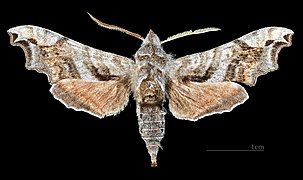Deidamia inscriptum
| Deidamia inscriptum | ||||||||||||
|---|---|---|---|---|---|---|---|---|---|---|---|---|

Deidamia inscripta |
||||||||||||
| Systematics | ||||||||||||
|
||||||||||||
| Scientific name of the genus | ||||||||||||
| Deidamia | ||||||||||||
| Clemens , 1859 | ||||||||||||
| Scientific name of the species | ||||||||||||
| Deidamia inscriptum | ||||||||||||
| ( Harris , 1839) |
Deidamia inscriptum is the only butterfly species of the genus Deidamia from the family of hawkers (Sphingidae).
features
Characteristics of the moth
The brownish colored moths have a fore wing length of 22 to 25 millimeters, which makes them one of the smallest swarmers in North America. This and the strongly serrated outer edge of the fore wing make it easy to determine the species. Your drawing is hardly variable.
Characteristics of the caterpillars
In the last stage, the caterpillars are relatively variable in color. They have a light lime-green to gray-green base color and have seven or eight pairs of vertical stripes. A pale yellow subdorsal stripe extends from the head to the anal horn . This strip is either a fine line or a wide band that merges with other strips.
Characteristics of the dolls
The doll varies from light brown marbled with dark brown spots to solid dark brown. Its surface is slightly rough and it has three distinct knots on its head. The trunk sheath is fused with the body. The cremaster is short, very rough, and ends in a single, sharp point.
Occurrence
The species is common in eastern North America. It occurs on the Atlantic coast from New England to north Florida as well as west to the southern half of the states bordering the Great Lakes, in the southeast of North Dakota to the edge of the Great Plains . In Nebraska, they can be found west to Chadron . In Canada it occurs in the extreme south of Québec , and in Ontario on the Niagara Peninsula , north to Pinhey Forest .
Way of life
The adults are among the first swarmers to appear in spring. They fly in one generation, in the north from late April to early June, in the south from late February to April. The animals are busy flower visitors in the evening, although they can only be found in a few nectar plants such as rhododendrons ( rhododendron ), flame flowers ( phlox ) and common lilac ( Syringa vulgaris ).
Food plants of the caterpillars
The caterpillars feed mainly on grapevine family (Vitaceae) such as grapevines ( Vitis ), Ampelopsis , self-climbing virgin vine ( Parthenocissus quinquefolia ) and common virgin vine ( Parthenocissus vitacea ). In the foothills of the Appalachian Mountains , they can often be found on Sauerbaum ( Oxydendrum arboreum ) from the heather family (Ericaceae).
development
The females lay their pale green eggs one by one on the undersides of the host plants. The caterpillars bend their heads back and vomit fluid when disturbed. Pupation takes place in a shallow cave in the ground.
supporting documents
Individual evidence
- ↑ a b c d e f g James P. Tuttle: The Hawkmoths of North America, A Natural History Study of the Sphingidae of the United States and Canada. The Wedge Entomological Research Foundation, Washington, DC 2007, ISBN 978-0-9796633-0-7 .
literature
- James P. Tuttle: The Hawkmoths of North America, A Natural History Study of the Sphingidae of the United States and Canada. The Wedge Entomological Research Foundation, Washington, DC 2007, ISBN 978-0-9796633-0-7 .




